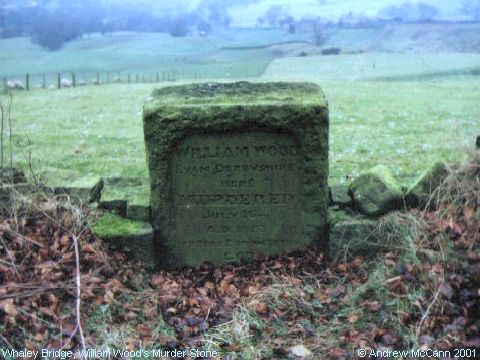Have you ever heard of a place where the earth itself seems to reject life? A spot so eerie that even scientists are left scratching their heads? That’s the story of William Wood’s barren ground, a patch of land in England that defies explanation. It’s a tale of murder, mystery, and something far stranger a place where the ground refuses to heal, no matter what.
This isn’t just a ghost story. It’s a real-life enigma that has puzzled locals and experts alike for centuries. So, let’s dive into the strange and unsettling mystery of William Wood’s barren ground.
The Night of the Murder
It all began on July 16, 1823, on a lonely stretch of road between Disley and Whaley Bridge in England. William Wood, a weaver from a small village, was returning home after selling his wares in Manchester. The moors were dark and desolate, the kind of place where you’d quicken your pace and keep an eye out for trouble.
Unfortunately for Wood, trouble found him. A gang of highwaymen ambushed him, clubbing him to death and stealing his possessions. The attack was so brutal that Wood’s head left a deep impression in the soft ground. It was a tragic end for a hardworking man, but what happened next was even more disturbing.
The Barren Ground
After Wood’s murder, something strange happened to the spot where he died. The deep impression left by his head didn’t fade away, as you’d expect. Instead, it remained intact for years, untouched by rain, wind, or time. Even more bizarre, the vegetation around it withered and died, leaving the area completely barren.

Locals began to whisper about the spot, calling it cursed. They claimed that nothing could grow there, and no amount of dirt or debris could fill the hole. It was as if the earth itself was mourning Wood’s death, refusing to let go of the tragedy that had occurred.
Alfred Fryer’s Investigation
The legend of the barren ground eventually caught the attention of Alfred Fryer, a well-known naturalist. In 1859, Fryer decided to investigate the site for himself. Accompanied by a local man who knew the story, Fryer visited the spot and scoffed at the idea of a cursed patch of land.
Determined to debunk the myth, Fryer packed dirt and stones from the road into the barren hole. He then retired to a nearby pub for a pint, confident that his experiment would prove the locals wrong. But when he returned an hour later, he was in for a shock.
The dirt and stones he had placed in the hole were scattered around, as if they had been forcefully ejected. Fryer repeated the experiment several times, each time with the same result. No matter what he did, the ground refused to hold the dirt.
Fryer, a man of science, was left dumbfounded. He had no explanation for what he had witnessed. In the end, he simply walked away, leaving the mystery unsolved.
Theories and Speculations
So, what caused the barren ground? Over the years, several theories have been proposed, ranging from the scientific to the supernatural.
- Geological Anomaly: Some suggest that the spot has unique geological properties, perhaps a natural void or underground spring that prevents dirt from settling.
- Chemical Contamination: Others believe that the ground might have been contaminated by something—perhaps from Wood’s body or the weapons used in the attack—that killed the vegetation and disrupted the soil.
- Supernatural Forces: Then there’s the more chilling explanation—that the ground is cursed, haunted by Wood’s restless spirit or the violence of his murder.
While each theory has its merits, none fully explain why the ground would reject dirt and stones so forcefully. It’s a mystery that continues to baffle experts to this day.
The Legacy of William Wood
William Wood’s story is more than just a tale of murder and mystery. It’s a reminder of how deeply history and folklore are intertwined. The barren ground serves as a physical marker of a tragic event, a place where the past refuses to be forgotten.
For the locals, the spot became a symbol of Wood’s unjust death, a place to reflect on the fragility of life and the enduring impact of violence. For scientists like Fryer, it was a puzzle that challenged their understanding of the natural world.
And for us, it’s a story that sparks curiosity and wonder. How can a patch of ground remain barren for so long? What forces are at work in places like this? The answers may never be clear, but the questions keep us searching.
Why This Mystery Matters
The barren ground of William Wood isn’t just a local legend—it’s a piece of history that invites us to explore the unknown. It reminds us that there are still mysteries in the world, things that science can’t yet explain.
It also highlights the power of storytelling. Wood’s murder could have been forgotten, just another tragic event lost to time. But the barren ground ensured that his story lived on, passed down through generations as a cautionary tale and a source of fascination.
Final Thoughts
The story of William Wood’s barren ground is a haunting reminder that some mysteries are never solved. It’s a tale that blends history, science, and folklore, leaving us with more questions than answers.
So, the next time you’re walking through a lonely stretch of land, take a moment to look around. You never know—you might just stumble upon a piece of history, a place where the past lingers and the ground itself tells a story.
The barren ground of William Wood is a testament to the enduring power of mystery. What do you think caused this strange phenomenon? A geological quirk, a chemical reaction, or something far more otherworldly? The truth, like the ground itself, remains elusive.

